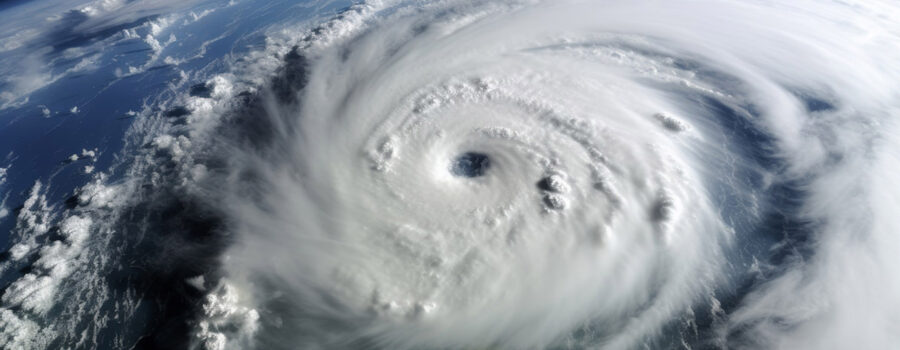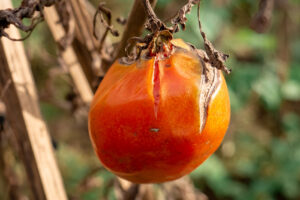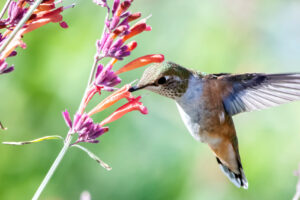Developing a food forest in a hurricane-prone region like north central Florida comes with challenges. For permaculture practitioners, these challenges are also opportunities to create resilient systems that not only survive storms but thrive in their aftermath. With thoughtful design, appropriate species selection, and smart water and energy management, we can live sustainably and securely even when the winds threaten our hard work.
Hurricanes and heavy rains are a fact of life in north central Florida. From tropical storms that bring inches of rain in a single day to hurricanes that uproot trees and flatten gardens, the extreme weather can challenge even the most experienced growers. Fortunately, permaculture offers resilient, regenerative solutions for managing water, wind, and disaster recovery.

Understanding Hurricanes
Before we can design for resilience, we need to understand the context. Here in growing zones 8b to 9a, we see frequent tropical storms and occasional hurricanes. High winds can uproot plants, snap stems, strip leaves, and break branches. Heavy rainfall & flooding will waterlog soil, suffocating roots and promoting fungal diseases, or washing away topsoil, nutrients, and mulch. In coastal areas, saltwater or pollutants can contaminate gardens, damaging soil health.
With over a thousand people moving in every day, and more than 140 million tourists visiting annually, Florida has a uniquely unprepared population on any given day. Florida experiences an average of twelve named storms and six hurricanes each year, and we can expect around three of them to be major hits (category 3 or higher), causing billions in damage. To put it mildly, we are vulnerable here.
Nature Can Humble Us
I first moved to Florida in 1986, and the weather made little impression on me for the first six years. I was happy to leave the frigid winters of Chicago and Indianapolis behind. Sun, sea, and warmth lulled me into happy complacency with year-round boating and diving adventures.
I lived in West Palm Beach when Hurricane Andrew was projected to hit our area with Category 5 winds. Even though it veered south at the last moment, leaving us with only minor damage, it devastated other areas that had not prepared as well. Towns in the gateway to the Keys looked like a war zone, recovery was slow, and it left me a bit traumatized.
We lived in Port St. Lucie in 2004 when Hurricanes Frances and Jeanne made direct hits one after the other within a few weeks. I watched trees pushed to the ground in one direction on the front end of the storm, then flip to the opposite side when the back of the storm came through. Some, we were able to prop back up afterward. Others were lost. It can break a gardener’s heart.

I had endured enough Florida storms in my first 25 years in Florida to be exhausted and stressed into gardening apathy. We moved to North Carolina for almost a decade, but when our son (a Florida native) decided to attend the University of Florida, I did a little research and found that Dunnellon had no history of hurricane damage (and had beautiful springs to boot). We relocated to be near him right as Covid hit, and I ended up getting permaculture design certified and developing a food forest during the strange times that followed.
Thankfully, we’ve never experienced a direct hit from a major hurricane here in Marion County. Even when hurricanes Helene and Milton threatened in 2024, they did not affect us much. While Milton did become the first official hurricane to enter our territory, it was only a category one, with recorded wind speeds at a relatively benign 78 mph, and it largely skirted our area.
Still, here in Florida, we do not take the threat of hurricanes lightly. We don’t panic, but we do prepare. Hurricane season affects us for half the year, from June through November. These months can bring high winds, torrential rain, flash flooding, and power outages. A poorly designed garden can lead to erosion and property damage. But, applying some permaculture principles can keep our food forests and gardens thriving.
Core Permaculture Principles for Storm Resilience
- Observe and Interact: Study your land’s topography, soil type, drainage patterns, and existing vegetation. Keep records in a garden journal. (I also document this on Instagram and find going back over the years of photos helpful.)
- Catch and Store Energy: Use solar systems, rainwater catchment, and windbreaks.
- Obtain a Yield: Storm-prepped systems can be productive and provide a harvest.
- Self-Regulation and Feedback: Adapt your design based on storm damage each year.
- Use Renewable Resources: Choose plants that are adapted to the region.
- Design from Patterns to Details: For example, shape your landscape to move and slow water.
Designing the Landscape for Storm Durability
- Swales and Berms
Create contours that slow and capture water. Swales are shallow trenches dug along the contour lines of the land, designed to slow and soak in rainwater. In Florida’s frequent rain events, they help prevent erosion, reduce runoff, and recharge groundwater. Swales are especially helpful in sandy soils, where water can quickly leach away from plant roots. - Raised Beds
In areas where standing water is common, consider elevating your planting beds. Raised beds or mounded rows promote rapid drainage, reduce root rot, and allow crops to continue producing after heavy rains. - Windbreaks
Use layered tree lines and living fences (like clumping bamboo or yaupon holly) to reduce wind speed. High winds can damage young trees, flatten vegetable beds, and strip leaves from perennial plants. Create layered windbreaks using a mix of hardy trees and shrubs. Space windbreaks to block prevailing winds—usually from the southeast and west—and protect sensitive zones like gardens, animal shelters, and greenhouses. - Root-anchoring Ground Covers
Vetiver grass, perennial peanut, and creeping thyme help prevent erosion. - Permeable Pathways
Gravel, mulch, and natural stone keep water flowing where it should.

Structures and Infrastructure
- Roof design: Metal roofs with reinforced fastening resist uplift better than shingles.
- Rain catchment: Elevated tanks with first-flush diverters and overflow drainage.
- Energy systems: Battery-backed solar setups can power essentials even during outages.
- Composting toilets and graywater systems: Reduce dependency on vulnerable municipal services. (Learn about Florida graywater regulations here)
- Secure greenhouses: Geodesic domes or low-profile hoop houses with reinforced anchoring are ideal.
Resilient Planting Strategies
- Choose Hurricane-tolerant Perennials
For example: loquat, mulberry, chaya, katuk, moringa, cassava, roselle (Florida cranberry), or lemongrass. Diversify your plantings with native species like beautyberry, elderberry, and muscadine grape to increase system resilience. - Avoid tall, brittle trees near the home: Swap pecan or pine with tough natives like live oak or sand pear.
- Layered planting: Tall overstory, midstory shrubs, and ground covers to protect soil and crops.
- Backup garden zones: Keep some crops in more sheltered spots (like behind buildings or fences). It will protect your favorite plants and allow you to keep spare plant material to propagate in case of loss. (I keep some indoors during a storm, and also in my greenhouse.)

Food and Water Security
- Store water: Rain barrels, cisterns, and wicking beds provide redundancy.
- Grow calorie-dense crops: Sweet potatoes, taro, pigeon peas, and Seminole pumpkins.
- Preserve harvests: Dehydrating, fermenting, and canning build food reserves before storms.
- Chickens and ducks: Keep small livestock secure in mobile coops you can relocate during a storm.
Community and Redundancy
- Connect with local permaculture networks: Share resources, labor, and information.
- Redundant systems: Two ways to get water, two ways to cook, multiple garden zones.
- Disaster plans: Create an evacuation plan, emergency supply kits, and lists of vital contacts.
Storm Prep and Recovery: Build Back Better
Integrate these storm prep practices into your annual routine:
- Stake or cage young trees and vines before hurricane season
- Prune trees in late spring to reduce wind resistance
- Mulch heavily and add ground cover plants wherever possible to prevent soil erosion
- Keep a backup nursery of plant cuttings in a protected zone or indoors.
After a storm, walk your site, assess damage, and observe (and record) what worked. Use each event as an opportunity to learn and adapt.
Closing Thoughts
Resilient permaculture design doesn’t mean resisting nature. It means working with it. By managing water intelligently, planting species that thrive in tough conditions, and protecting your garden with smart design, you can create a homestead that weathers the storm and comes back stronger each time.
Permaculture isn’t just about sustainability, it’s about resilience, whole-system thinking, and regenerative design. And in hurricane country, that kind of thinking isn’t optional — it’s essential. Whether you’re homesteading on five acres or growing food in a suburban backyard, living the permaculture life in a hurricane zone is entirely achievable — and incredibly rewarding.
Copyright © 2025 Fruitful Food Forestry & Lauren Lynch. No portion of the original content on this website may be reproduced, in any language, without express written consent.










Leave a Reply
Your email is safe with us.